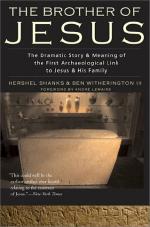Issue Date: June 20, 2003
Reviewed by FRANCIS J. MOLONEY A Jewish ossuary, a stone box, provenance unknown, used to gather the bones of the deceased, has generated this book. The practice of using such “bone boxes” was widespread in Israel across the first and second centuries C.E. This particular ossuary, recently made public, bears a remarkable Aramaic inscription: Ya‘aqob bar Yoseph ’ahui de Yeshua‘: “James, son of Joseph, brother of Jesus.” Is this the final resting place for the remains of the figure from the pages of the New Testament, James of Jerusalem, whom St Paul calls “the brother of the Lord” (Galatians 1:18)? Herschel Shanks, the editor of Biblical Archeological Review, Bible Review and Archeological Odyssey, addresses this question. He has been closely associated with the process that led to the release of information about the ossuary. The narrative of the discovery, from the first contacts made between Shanks and André Lemaire, a distinguished scholar of Semitic scripts, to its unveiling, is compelling reading. One senses that Schanks is bursting with enthusiasm and conviction that he has the discovery of the Christian era under his eyes. But he honestly faces the possibility that the box may not be genuine, that the inscription is a fake, written later, or that perhaps the reference to Jesus was added, as well as the problem (which is major) that we have no idea where the box was found. Each of these difficulties is aired and laid to rest, in so far as that is possible, with great clarity. Shanks, despite his enthusiasm and conviction, admits that absolute certainty in these matters cannot be claimed. Witherington, professor of New Testament at Asbury Theological Seminary, is less critical. He attempts to reconstruct a “history of James,” from his being a brother of Jesus to becoming a disciple as a result of Jesus’ death and resurrection. From there James emerges as the head of the Jerusalem church, a committed Jewish-Christian who was able to act as a mediator between the original Jewish church and the spreading Gentile church. His death and the later legends that developed around him are evaluated. Witherington closes by insisting that with the box we have conclusive proof that Jesus had at least one blood brother, and that the Catholic tradition should rethink its attempts to explain the New Testament references to “the brothers and sisters” of Jesus. The main problem with the second half of the book lies in Witherington’s assessment of the material from the New Testament. The “rumor” that the box was found in Silwan is taken as a fact, and his reconstruction of James’ conversion to become a follower of Jesus is pure speculation. From there he uses material from the letters of Paul, the Acts of the Apostles and the Letter of James, without sufficient critical discrimination. A crucial moment in the New Testament’s presentation of James is found at the so-called Council of Jerusalem, reported in Acts 15. Luke, the author of the gospel that bears his name and the Acts of the Apostles, may be using sources for this account, but he is also developing a portrait of James that suits his purpose. A major moment in turning the church’s mission “to the ends of the earth” (Acts 1:8), there are many tensions between Acts 15 and the more realistic presentation of the turn toward the Gentiles as we find it in Paul. But Witherington uses Acts 15 as if it were almost an eyewitness account. Similarly, he takes it for granted that we have the authentic voice of James in the Letter of James, a position that many would question. He raises some critical questions in his footnotes, generally resolving them by reference to his own writings. There is no engagement with different scholarly opinion. Discoveries like this call for care, and perhaps alert us to the increasing need for Catholic readers to become critically familiar with their origins. Might I suggest that readers of the National Catholic Reporter could look to the work of J.A. Fitzmyer, “Whose Name Is This?” in America (Nov. 18, 2002). The ossuary is an important discovery, and we need to be as informed about it as possible. Shanks and Fitzmyer are a good place to start. Salesian Fr. Francis J. Moloney is the Katharine Drexel Professor of Religious Studies at The Catholic University of America in Washington. National Catholic Reporter, June 20, 2003 |
